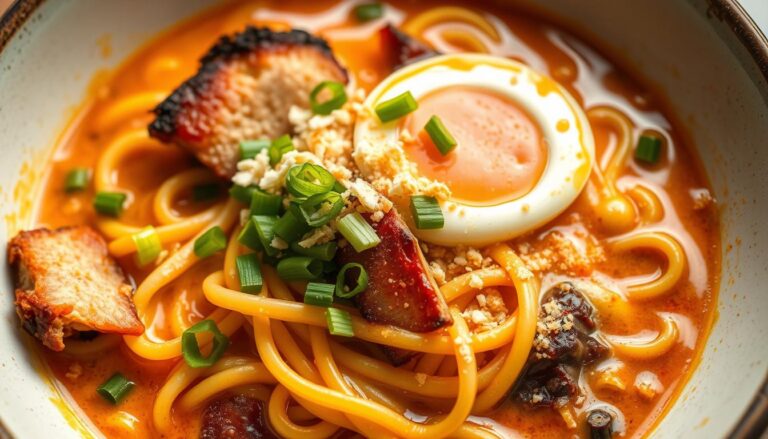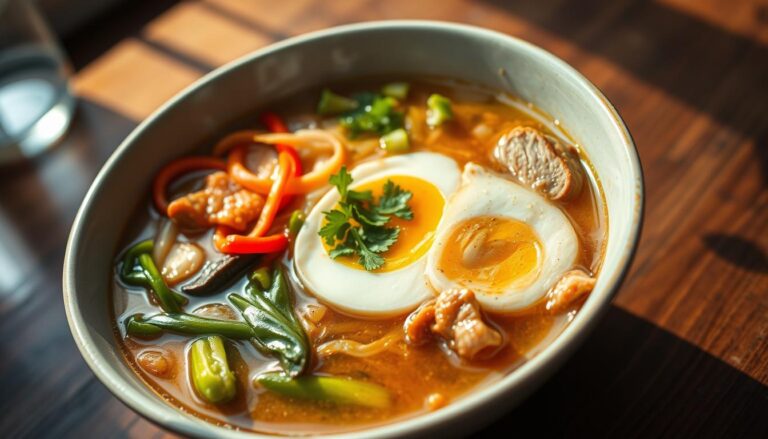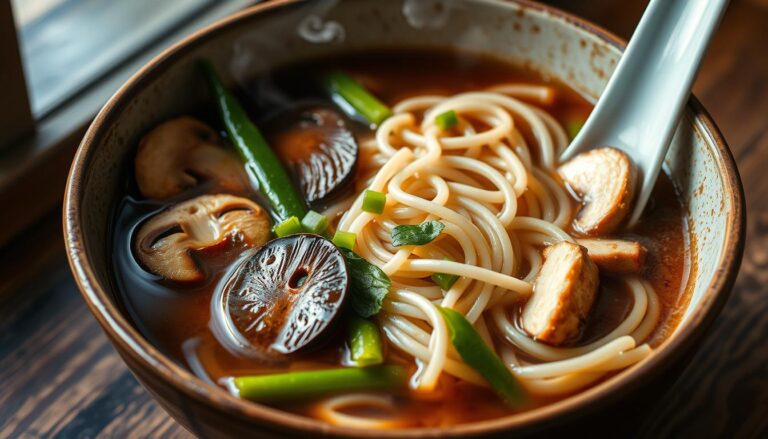Homemade Seafood Ramen: A Flavorful Japanese Dish
Explore the authentic flavors of Japan with our homemade seafood ramen recipe. It turns your kitchen into a culinary wonderland. Ramen, loved in Japan, lets you make restaurant-quality meals at home.
This seafood ramen recipe is more than food. It’s a journey of fresh ocean tastes and Japanese cooking. You’ll learn to make a bowl of ramen that excites your taste buds and warms your heart.
Picture a bowl filled with juicy shrimp, tender scallops, and soft fish in a perfect broth. Each bite of this homemade seafood ramen is a story of flavor and tradition. It’s perfect for both seasoned cooks and curious food lovers.
In this guide, I’ll show you how to make a seafood ramen that truly captures Japan’s essence. You’ll learn about choosing the freshest seafood, making a rich broth, and building a stunning bowl. Get ready for a tasty adventure that will change how you see homemade ramen.
Seafood ramen, from Tokyo’s street vendors to your kitchen, is a mix of simplicity and elegance. This recipe is your ticket to Japan’s rich culinary world, one delicious bowl at a time.
Introduction to Traditional Japanese Seafood Ramen
Authentic seafood ramen is a journey through Japan’s food traditions. It shows Japan’s deep love for food, mixing old traditions with local flavors.
History of Ramen in Japanese Cuisine
Ramen started with Chinese immigrants who brought wheat noodles to Japan in the late 1800s. After World War II, it became a favorite dish across the country. Street vendors and small restaurants made it their own, starting a food revolution.
- 1880s: Chinese immigrants introduce wheat noodles
- 1940s: Ramen becomes widespread in Japan
- 1950s: First commercial instant ramen developed
Evolution of Seafood Variations
Coastal areas were key in making seafood ramen. Fishermen and chefs added fresh sea food to ramen. This made seafood ramen a special dish, showing off the sea’s gifts in every bowl.
Cultural Significance
Ramen is more than food in Japan. It’s about comfort, creativity, and coming together. From street stalls to fancy restaurants, ramen shows Japan’s love for food. It turns simple things into amazing meals.
| Ramen Type | Key Seafood Ingredients | Regional Origin |
|---|---|---|
| Hokkaido Seafood Ramen | Hokkaido crab, scallops | Northern Japan |
| Nagasaki Seafood Ramen | Sardines, bonito | Kyushu Region |
Essential Ingredients for Authentic Seafood Ramen
To make a real seafood ramen, you need the right ingredients. They add depth and richness to your dish. I’ll show you the key parts that make a meal special.
The best seafood ramen starts with top-notch seafood. Fresh ingredients are key to making a dish that tastes like Japan.
Seafood Selection
- Shrimp: 8 oz, large, peeled and deveined
- Scallops: 4 oz, fresh or frozen
- Optional: Crab meat or squid for additional variety
Noodle and Broth Essentials
- Ramen noodles: 2 packages, fresh preferred
- Miso paste: 3 tbsp, white or yellow
- Low-sodium soy sauce: 2 tbsp
Vegetables are important for your seafood ramen. Add green onions, nori seaweed, and bean sprouts. They add flavor and texture.
Flavor Enhancers
- Garlic: 2 cloves, minced
- Ginger: 1-inch piece, freshly grated
- Sesame oil: 1 tbsp for finishing
Choosing the best ingredients is the secret to a great seafood ramen. Each part adds its own flavor. Together, they make a dish you’ll remember.
The Perfect Seafood Ramen Recipe
Making easy seafood ramen at home is simple. I’ll show you how to make the best seafood ramen recipe. It’s perfect for both beginners and experienced cooks.
Let’s dive into the key steps for making great ramen. Knowing how to prepare is essential for a tasty dish.
Preparation Time and Serving Details
Start your ramen journey with good planning. Here’s what you need to know:
- Total Prep Time: 40 minutes
- Cooking Time: 25 minutes
- Servings: 4 generous portions
Required Kitchen Equipment
To make the best seafood ramen, you’ll need a few tools:
- Large pot: 6-quart capacity
- Sharp chef’s knife
- Sturdy cutting board
- Fine-mesh strainer
- Ladle
- 4 large serving bowls
Recipe Difficulty Level
This easy seafood ramen recipe is for all cooks. It’s moderately difficult, needing some basic skills. Follow the instructions, and you’ll make a dish that will wow everyone.
Being organized is key. Prepare everything before you start. This way, cooking will be fun and easy. Remember, the more you practice, the better your ramen will get!
Creating the Ultimate Ramen Broth Base

Making the perfect seafood ramen broth is like creating a work of art. It turns a simple meal into a feast for the senses. My recipe combines Japanese traditions with deep, savory flavors.
The best seafood ramen broth starts with top-notch stock. Use a mix of ingredients for depth and complexity:
- Dried kombu (kelp): Adds profound oceanic essence
- Bonito flakes: Introduces intense seafood undertones
- Shellfish shells: Concentrates marine flavors
- Aromatic vegetables: Builds fundamental taste profile
Let’s look at what makes a seafood ramen broth stand out:
| Ingredient | Quantity | Purpose |
|---|---|---|
| Kombu | 2 sheets | Base umami flavor |
| Bonito Flakes | 1/2 cup | Intense seafood notes |
| Shrimp Shells | 1 cup | Rich maritime essence |
| White Miso Paste | 3 tbsp | Depth and complexity |
Creating an amazing seafood ramen broth takes time. Slowly pulling out flavors lets each ingredient shine. Simmer slowly, strain well, and taste often to get a broth that will make your ramen unforgettable.
Selecting and Preparing Fresh Seafood Components
Making a homemade seafood ramen recipe begins with picking the right seafood. The quality and how you prepare it can turn a simple meal into a memorable experience.
For your seafood ramen, it’s key to choose the freshest seafood. I’ll show you the best seafood to pick and how to prepare it. This will make your homemade seafood ramen taste like it’s from a restaurant.
Types of Seafood for Ramen
- Shrimp: Large (16-20 count), sweet and tender
- Scallops: Sea scallops, providing a delicate flavor
- White Fish: Cod or halibut, adding mild texture
Cleaning and Preparation Methods
- Rinse seafood under cold running water
- Pat dry completely with paper towels
- Remove any visible shells or muscle attachments
- For shrimp: Devein carefully to ensure clean presentation
Seafood Storage Tips
Storing seafood right is key to keeping it fresh for your ramen. Store it in the fridge at 40°F or below. Use it within 1-2 days to keep the flavor and freshness at their best.
| Seafood Type | Recommended Storage | Maximum Storage Time |
|---|---|---|
| Shrimp | Sealed container, on ice | 1-2 days |
| Scallops | Wrapped in damp paper towel | 1 day |
| White Fish | Sealed plastic bag | 2 days |
By following these tips, your seafood ramen will always taste amazing.
Noodle Selection and Preparation Techniques
Choosing the right noodles is key to a great seafood ramen noodle soup. Noodles are the heart of ramen, adding texture and soaking up broth flavors.
There are two main noodle types: fresh and dried. Each has its own special qualities for your soup.
- Fresh Ramen Noodles: Loved by ramen fans for their real texture
- Dried Ramen Noodles: A handy choice with a longer shelf life
It’s important to know the differences between noodle types. This will help you make your seafood ramen noodle soup even better.
| Noodle Type | Cooking Time | Texture | Recommended Use |
|---|---|---|---|
| Fresh Ramen Noodles | 2-3 minutes | Chewy, springy | Immediate cooking |
| Dried Ramen Noodles | 4-5 minutes | Firmer, less elastic | Pantry staple |
Cooking noodles right is as important as picking the right type. Always cook noodles apart from the broth. This keeps them perfectly al dente in your seafood ramen noodle soup.
- Boil water in a separate pot
- Add noodles and stir gently
- Cook until just tender
- Drain immediately and rinse with cold water
Pro tip: Cook noodles a bit less than you think. They’ll soften more when in the hot broth. This keeps them springy and delicious in every bite.
Essential Seasonings and Condiments
To make an authentic seafood ramen, you need the right mix of Japanese seasonings. These seasonings turn a simple dish into a flavorful masterpiece. The right condiments make your seafood ramen a feast for the senses.
The secret to a great spicy seafood ramen is in its seasonings. Each one adds a layer of flavor, making the dish rich and complex.
Traditional Japanese Seasonings
- Soy Sauce: 2 tbsp, low-sodium variety
- Miso Paste: 3 tbsp, white or yellow
- Sesame Oil: 1 tsp, toasted for rich flavor
- Rice Vinegar: 1 tsp, for subtle tanginess
Optional Flavor Enhancers
Want to make your seafood ramen even more intense? Try these flavor boosters:
- Chili Oil: 1 tsp for added heat
- Garlic Paste: 1 tsp for extra depth
- Shichimi Togarashi: Japanese seven-spice blend
- Kombu Powder: Dried kelp for umami flavor
Pro tip: Start with small amounts of these seasonings and adjust to your personal taste. The key to an exceptional spicy seafood ramen recipe is finding the perfect balance that complements the delicate seafood flavors.
| Seasoning | Flavor Profile | Recommended Amount |
|---|---|---|
| Soy Sauce | Salty, umami | 2 tbsp |
| Chili Oil | Spicy, warming | 1 tsp |
| Miso Paste | Rich, fermented | 3 tbsp |
Seasoning is all about what you like. Try different traditional and optional condiments to make a seafood ramen that’s truly yours.
Step-by-Step Cooking Instructions

Making the perfect seafood ramen recipe needs precision and skill. I’ll guide you through each step. This way, your dish will be delicious and true to its roots.
- Prepare the Broth
- Heat homemade or store-bought fish stock in a large pot
- Add miso paste, soy sauce, fresh ginger, and minced garlic
- Simmer for 15-20 minutes to develop rich flavors
- Cook the Noodles
- Boil water in a separate pot
- Cook fresh ramen noodles for 2-3 minutes
- Cook dried noodles for 4-5 minutes until al dente
- Drain and rinse with cold water to stop cooking
- Seafood Preparation
- Select fresh seafood like shrimp, scallops, or fish
- Clean and pat dry seafood before cooking
- Add seafood to simmering broth
- Cook for 2-3 minutes until just done
The secret to easy seafood ramen is timing. Add seafood last to avoid overcooking. This keeps its texture soft and delicate. Place cooked noodles in bowls, then add hot broth and seafood. Finish with fresh herbs.
Pro tip: Prepare all ingredients before cooking. This makes the process smooth and lets you make authentic seafood ramen at home.
Garnishing and Presentation Tips
Turning your seafood ramen into a masterpiece is all about garnishing and presentation. The right touches can make your dish a feast for the eyes and taste buds.
Japanese ramen presentation is all about art and precision. I’ll show you how to make a bowl that looks as good as it tastes.
Classic Garnish Selections
- Green Onions: 2 stalks, thinly sliced for a fresh, sharp accent
- Nori Seaweed: 1 sheet, cut into delicate strips
- Soft-Boiled Egg: Perfectly halved, revealing a creamy golden center
- Corn Kernels: Fresh or thawed, adding sweet bursts of flavor
Arrangement Techniques
For a stunning seafood ramen, place garnishes with care. Group them to create a colorful and textured bowl.
| Garnish | Placement Tip | Visual Impact |
|---|---|---|
| Green Onions | Sprinkle across top | Adds fresh green color |
| Soft-Boiled Egg | Center of bowl | Creates focal point |
| Nori Strips | Along side of bowl | Provides dark contrast |
| Corn | Scattered strategically | Adds bright yellow pops |
Pro tip: Use white ceramic bowls to highlight your seafood ramen’s colors. The white background will make each garnish pop, making your dish look like it’s from a restaurant.
Nutritional Information and Health Benefits
Making homemade seafood ramen is more than just tasty—it’s about feeding your body well. When you make it yourself, you get a meal full of good stuff that restaurants often can’t match.

Homemade seafood ramen is a healthy mix of nutrients. It has seafood, broth, and other ingredients that make it both filling and full of good stuff.
Caloric Content Insights
The calories in seafood ramen depend on what you put in it. But, a typical bowl has about 400-450 calories. This is a good amount for a meal that’s not too heavy.
- Average serving size: 1 bowl (approximately 16-20 oz)
- Calorie range: 400-450 calories
- Recommended for balanced meal planning
Protein and Mineral Powerhouse
Seafood is packed with protein. In your homemade ramen, you’ll get about 25-30 grams of protein per bowl. This is great for keeping your muscles strong and helping them heal.
| Nutrient | Amount per Serving | Health Benefit |
|---|---|---|
| Protein | 25-30g | Muscle support and repair |
| Omega-3 Fatty Acids | 1.5-2.5g | Heart and brain health |
| Selenium | 40-60 mcg | Antioxidant protection |
By making seafood ramen at home, you can control what goes into it. You can make it healthier by using less salt, adding more protein, or meeting special dietary needs. And you’ll enjoy a meal that’s both tasty and good for you.
Variations and Customization Options
Making an easy seafood ramen recipe opens up a world of creativity. I’ll show you how to turn simple seafood ramen into a dish that’s all your own. This way, it fits your taste perfectly.
Seafood fans have many ways to make their spicy seafood ramen even better. Ramen is all about trying new things. It lets you play with different ingredients and flavors.
Seafood Variation Options
- Swap traditional seafood with unique alternatives:
- Squid rings for added texture
- Fish balls for extra protein
- Shrimp tempura as a crispy topping
Spice and Flavor Customizations
- Heat level adjustments for spicy seafood ramen:
- Mild: 1 tsp chili oil
- Medium: 2 tsp sriracha
- Intense: 3 tsp Korean gochujang
Vegetable Enhancement Techniques
- Recommended vegetable additions:
- Fresh spinach: 1 cup
- Sliced mushrooms: ½ cup
- Crispy nori strips
- Green onion garnish
Trying different broths can change your easy seafood ramen completely. You might like tonkotsu (pork-based) or shoyu (soy sauce-based). These can add new flavors that go great with your seafood.
The secret to amazing ramen is finding the right mix of flavors and textures. So, don’t be shy. Make your recipe your own and have fun with it!
Conclusion
Making the best seafood ramen at home is more than cooking. It’s an art that connects you to Japan’s culinary traditions. Your homemade ramen lets you choose every ingredient, making it healthier and more personal than restaurant food.
The secret to great homemade seafood ramen is balancing flavors. Use fresh seafood, a well-made broth, and the right seasonings. This turns a simple meal into a masterpiece. With each bowl, you’ll get better and more confident.
Practice is key to mastering ramen. Start with the basics, try different seafood, and adjust recipes to your taste. Homemade ramen lets you show off your creativity and love for Japanese food.
Your ramen adventure is just starting. Enjoy the flavors and be proud of making top-notch meals at home. With time and effort, you’ll become a skilled chef who wows everyone with your seafood ramen.







